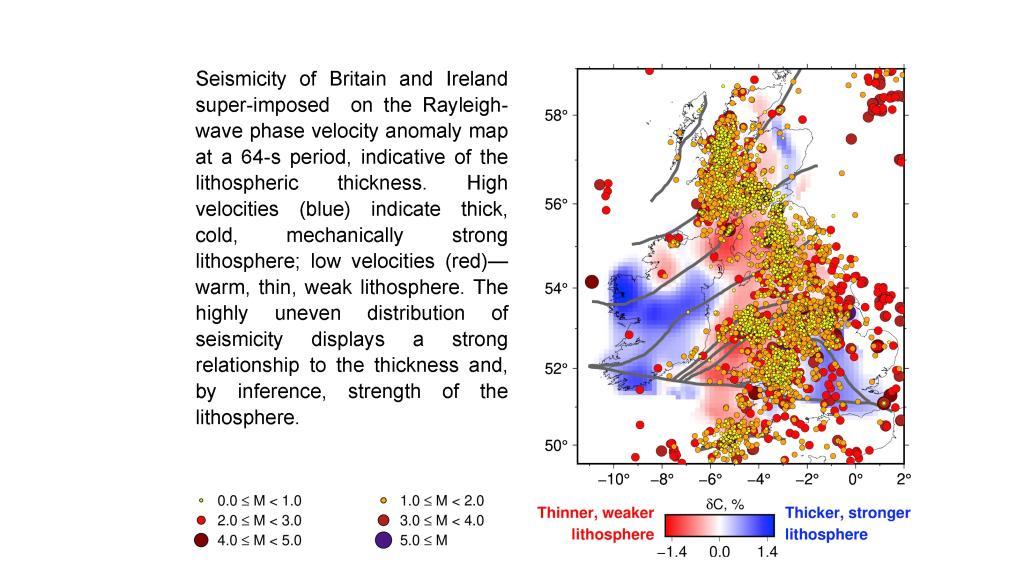
Lead supervisor: Sergei Lebedev, Earth Sciences
Co-supervisor: Nick Rawlinson, Earth Sciences
Brief summary:
Geophysical investigation of how the surprisingly strong lateral variations in the lithospheric structure of Britain and Ireland control their enigmatic seismicity, with important global inferences and applications.
Importance of the area of research concerned:
The age, structure and thickness of the lithosphere (tectonic plate) beneath Britain and Ireland are poorly known. Yet, the lithospheric properties determine, to a large extent, what happens at and near the surface. Recent seismic tomography revealed unexpectedly strong variations in the thickness and temperature of the lithosphere and hinted at a clue to a long-standing problem. The enigmatic, uneven distribution of seismicity in Britain and Ireland may be explained by variations in the lithospheric thickness, temperature and, consequently, strength (which determines what lithospheric blocks are more likely to deform and produce earthquakes). The recent tomography, however, covered only a part of Britain and yielded only a non-unique seismic-velocity model. Moreover, puzzling complexities in the seismicity-lithospheric structure relationship remain unexplained and are likely to prompt new discoveries on the thermal structure and tectonic evolution of Britain and Ireland. The thermal structure of the lithosphere also has important economic and societal implications as it determines the (renewable) geothermal energy resources, here and elsewhere around the world.
Project summary :
This project is a part of a major ongoing effort to image the lithosphere and underlying mantle beneath Britain, Ireland and surroundings in great regional detail, to determine the 3D thermal structure of the lithosphere using seismology and computational petrology, and to investigate how it shapes seismicity, volcanism and geothermal energy resources. The main focus of this project is on the relationship of seismicity with the thermally controlled lithospheric strength and seismogenic layer thickness. In order to establish this relationship, seismic imaging and petrological modelling will also be performed. The results will have important implications for seismic hazard in the UK (increasingly important due to the growing population density and infrastructure development) and for our understanding of the basic mechanisms behind intraplate seismicity distributions around the world.
What will the student do?:
The student will use an unprecedentedly dense coverage of Britain and Ireland with seismic stations. These will include recently deployed stations across Ireland, existing ones in Britain, and the new stations that will be deployed in key remaining gaps, from SE England to Scotland and the Outer Hebrides, in which the student will have an opportunity to take part. The poorly known structure of the lithosphere and underlying mantle will now be imaged with high resolution using seismic tomography. Then, state-of-the-art methods of computation petrology will be used to invert the seismic and other data for a 3D thermal model of the lithosphere and underlying mantle, including the thickness of the lithosphere. The thermal structure of the lithosphere will be used to compute its mechanical strength and the seismogenic layer thickness. This will enable the student to quantify how the lithospheric structure controls seismicity. The detailed mapping of the lithospheric blocks making up the islands should also enable the student to make new inferences and advance the current understanding of their tectonic assembly and evolution, as well as their geothermal energy resource distribution.
References - references should provide further reading about the project:
Lebedev, S., J. Grannell, P. Arroucau, R. Bonadio, N. Piana Agostinetti, C.J. Bean. Seismicity of Ireland, and why it is so low: How the thickness of the lithosphere controls intraplate seismicity, Geophys. J. Int., 235, 431-447, https://doi.org/10.1093/gji/ggad194, 2023.
Fullea, J., S. Lebedev, Z. Martinec, N. L. Celli, 2021. WINTERC-G: mapping the upper mantle thermochemical heterogeneity from coupled geophysical-petrological inversion of seismic waveforms, heat flow, surface elevation and gravity satellite data. Geophys. J. Int., 226, 146-191, https://doi.org/10.1093/gji/ggab094
Celli, N.L., S. Lebedev, A.J. Schaeffer, C. Gaina, 2020. African cratonic lithosphere carved by mantle plumes. Nature Communications, 11, 92, doi:10.1038/s41467-019-13871-2
Applying
You can find out about applying for this project on the Department of Earth Sciences page.